Francesco Sovrano
Explicit vs. Implicit Biographies: Evaluating and Adapting LLM Information Extraction on Wikidata-Derived Texts
Sep 18, 2025Abstract:Text Implicitness has always been challenging in Natural Language Processing (NLP), with traditional methods relying on explicit statements to identify entities and their relationships. From the sentence "Zuhdi attends church every Sunday", the relationship between Zuhdi and Christianity is evident for a human reader, but it presents a challenge when it must be inferred automatically. Large language models (LLMs) have proven effective in NLP downstream tasks such as text comprehension and information extraction (IE). This study examines how textual implicitness affects IE tasks in pre-trained LLMs: LLaMA 2.3, DeepSeekV1, and Phi1.5. We generate two synthetic datasets of 10k implicit and explicit verbalization of biographic information to measure the impact on LLM performance and analyze whether fine-tuning implicit data improves their ability to generalize in implicit reasoning tasks. This research presents an experiment on the internal reasoning processes of LLMs in IE, particularly in dealing with implicit and explicit contexts. The results demonstrate that fine-tuning LLM models with LoRA (low-rank adaptation) improves their performance in extracting information from implicit texts, contributing to better model interpretability and reliability.
Can Global XAI Methods Reveal Injected Bias in LLMs? SHAP vs Rule Extraction vs RuleSHAP
May 16, 2025Abstract:Generative AI systems can help spread information but also misinformation and biases, potentially undermining the UN Sustainable Development Goals (SDGs). Explainable AI (XAI) aims to reveal the inner workings of AI systems and expose misbehaviours or biases. However, current XAI tools, built for simpler models, struggle to handle the non-numerical nature of large language models (LLMs). This paper examines the effectiveness of global XAI methods, such as rule-extraction algorithms and SHAP, in detecting bias in LLMs. To do so, we first show a text-to-ordinal mapping strategy to convert non-numerical inputs/outputs into numerical features, enabling these tools to identify (some) misinformation-related biases in LLM-generated content. Then, we inject non-linear biases of varying complexity (univariate, conjunctive, and non-convex) into widespread LLMs like ChatGPT and Llama via system instructions, using global XAI methods to detect them. This way, we found that RuleFit struggles with conjunctive and non-convex biases, while SHAP can approximate conjunctive biases but cannot express them as actionable rules. Hence, we introduce RuleSHAP, a global rule extraction algorithm combining SHAP and RuleFit to detect more non-univariate biases, improving injected bias detection over RuleFit by +94% (MRR@1) on average.
Large Language Models for In-File Vulnerability Localization Can Be "Lost in the End"
Feb 09, 2025Abstract:Recent advancements in artificial intelligence have enabled processing of larger inputs, leading everyday software developers to increasingly rely on chat-based large language models (LLMs) like GPT-3.5 and GPT-4 to detect vulnerabilities across entire files, not just within functions. This new development practice requires researchers to urgently investigate whether commonly used LLMs can effectively analyze large file-sized inputs, in order to provide timely insights for software developers and engineers about the pros and cons of this emerging technological trend. Hence, the goal of this paper is to evaluate the effectiveness of several state-of-the-art chat-based LLMs, including the GPT models, in detecting in-file vulnerabilities. We conducted a costly investigation into how the performance of LLMs varies based on vulnerability type, input size, and vulnerability location within the file. To give enough statistical power to our study, we could only focus on the three most common (as well as dangerous) vulnerabilities: XSS, SQL injection, and path traversal. Our findings indicate that the effectiveness of LLMs in detecting these vulnerabilities is strongly influenced by both the location of the vulnerability and the overall size of the input. Specifically, regardless of the vulnerability type, LLMs tend to significantly (p < .05) underperform when detecting vulnerabilities located toward the end of larger files, a pattern we call the 'lost-in-the-end' effect. Finally, to further support software developers and practitioners, we also explored the optimal input size for these LLMs and presented a simple strategy for identifying it, which can be applied to other models and vulnerability types. Eventually, we show how adjusting the input size can lead to significant improvements in LLM-based vulnerability detection, with an average recall increase of over 37% across all models.
Aligning XAI with EU Regulations for Smart Biomedical Devices: A Methodology for Compliance Analysis
Aug 27, 2024Abstract:Significant investment and development have gone into integrating Artificial Intelligence (AI) in medical and healthcare applications, leading to advanced control systems in medical technology. However, the opacity of AI systems raises concerns about essential characteristics needed in such sensitive applications, like transparency and trustworthiness. Our study addresses these concerns by investigating a process for selecting the most adequate Explainable AI (XAI) methods to comply with the explanation requirements of key EU regulations in the context of smart bioelectronics for medical devices. The adopted methodology starts with categorising smart devices by their control mechanisms (open-loop, closed-loop, and semi-closed-loop systems) and delving into their technology. Then, we analyse these regulations to define their explainability requirements for the various devices and related goals. Simultaneously, we classify XAI methods by their explanatory objectives. This allows for matching legal explainability requirements with XAI explanatory goals and determining the suitable XAI algorithms for achieving them. Our findings provide a nuanced understanding of which XAI algorithms align better with EU regulations for different types of medical devices. We demonstrate this through practical case studies on different neural implants, from chronic disease management to advanced prosthetics. This study fills a crucial gap in aligning XAI applications in bioelectronics with stringent provisions of EU regulations. It provides a practical framework for developers and researchers, ensuring their AI innovations advance healthcare technology and adhere to legal and ethical standards.
An Empirical Study on Compliance with Ranking Transparency in the Software Documentation of EU Online Platforms
Dec 22, 2023Abstract:Compliance with the European Union's Platform-to-Business (P2B) Regulation is challenging for online platforms, and assessing their compliance can be difficult for public authorities. This is partly due to the lack of automated tools for assessing the information (e.g., software documentation) platforms provide concerning ranking transparency. Our study tackles this issue in two ways. First, we empirically evaluate the compliance of six major platforms (Amazon, Bing, Booking, Google, Tripadvisor, and Yahoo), revealing substantial differences in their documentation. Second, we introduce and test automated compliance assessment tools based on ChatGPT and information retrieval technology. These tools are evaluated against human judgments, showing promising results as reliable proxies for compliance assessments. Our findings could help enhance regulatory compliance and align with the United Nations Sustainable Development Goal 10.3, which seeks to reduce inequality, including business disparities, on these platforms.
A Survey on Methods and Metrics for the Assessment of Explainability under the Proposed AI Act
Oct 21, 2021
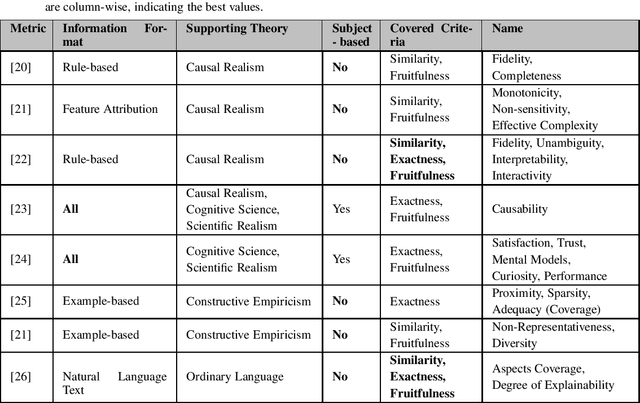
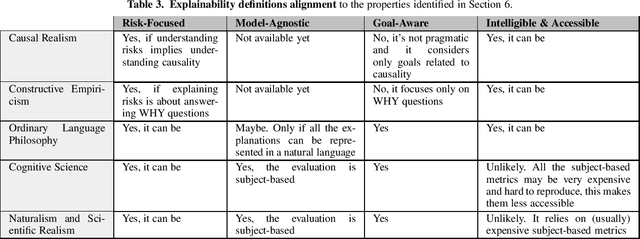
Abstract:This study discusses the interplay between metrics used to measure the explainability of the AI systems and the proposed EU Artificial Intelligence Act. A standardisation process is ongoing: several entities (e.g. ISO) and scholars are discussing how to design systems that are compliant with the forthcoming Act and explainability metrics play a significant role. This study identifies the requirements that such a metric should possess to ease compliance with the AI Act. It does so according to an interdisciplinary approach, i.e. by departing from the philosophical concept of explainability and discussing some metrics proposed by scholars and standardisation entities through the lenses of the explainability obligations set by the proposed AI Act. Our analysis proposes that metrics to measure the kind of explainability endorsed by the proposed AI Act shall be risk-focused, model-agnostic, goal-aware, intelligible & accessible. This is why we discuss the extent to which these requirements are met by the metrics currently under discussion.
Generating User-Centred Explanations via Illocutionary Question Answering: From Philosophy to Interfaces
Oct 02, 2021



Abstract:We propose a new method for generating explanations with Artificial Intelligence (AI) and a tool to test its expressive power within a user interface. In order to bridge the gap between philosophy and human-computer interfaces, we show a new approach for the generation of interactive explanations based on a sophisticated pipeline of AI algorithms for structuring natural language documents into knowledge graphs, answering questions effectively and satisfactorily. With this work we aim to prove that the philosophical theory of explanations presented by Achinstein can be actually adapted for being implemented into a concrete software application, as an interactive and illocutionary process of answering questions. Specifically, our contribution is an approach to frame illocution in a computer-friendly way, to achieve user-centrality with statistical question answering. In fact, we frame illocution, in an explanatory process, as that mechanism responsible for anticipating the needs of the explainee in the form of unposed, implicit, archetypal questions, hence improving the user-centrality of the underlying explanatory process. More precisely, we hypothesise that given an arbitrary explanatory process, increasing its goal-orientedness and degree of illocution results in the generation of more usable (as per ISO 9241-210) explanations. We tested our hypotheses with a user-study involving more than 60 participants, on two XAI-based systems, one for credit approval (finance) and one for heart disease prediction (healthcare). The results showed that our proposed solution produced a statistically significant improvement (hence with a p-value lower than 0.05) on effectiveness. This, combined with a visible alignment between the increments in effectiveness and satisfaction, suggests that our understanding of illocution can be correct, giving evidence in favour of our theory.
Making Things Explainable vs Explaining: Requirements and Challenges under the GDPR
Oct 02, 2021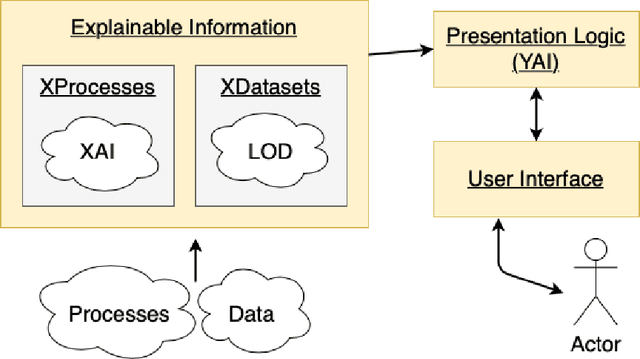
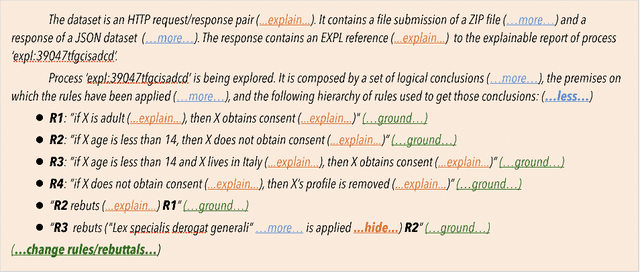
Abstract:The European Union (EU) through the High-Level Expert Group on Artificial Intelligence (AI-HLEG) and the General Data Protection Regulation (GDPR) has recently posed an interesting challenge to the eXplainable AI (XAI) community, by demanding a more user-centred approach to explain Automated Decision-Making systems (ADMs). Looking at the relevant literature, XAI is currently focused on producing explainable software and explanations that generally follow an approach we could term One-Size-Fits-All, that is unable to meet a requirement of centring on user needs. One of the causes of this limit is the belief that making things explainable alone is enough to have pragmatic explanations. Thus, insisting on a clear separation between explainabilty (something that can be explained) and explanations, we point to explanatorY AI (YAI) as an alternative and more powerful approach to win the AI-HLEG challenge. YAI builds over XAI with the goal to collect and organize explainable information, articulating it into something we called user-centred explanatory discourses. Through the use of explanatory discourses/narratives we represent the problem of generating explanations for Automated Decision-Making systems (ADMs) into the identification of an appropriate path over an explanatory space, allowing explainees to interactively explore it and produce the explanation best suited to their needs.
Explanation-Aware Experience Replay in Rule-Dense Environments
Sep 29, 2021

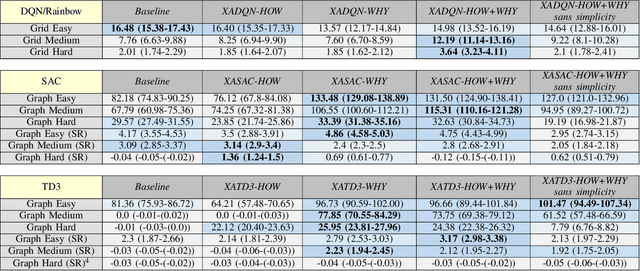
Abstract:Human environments are often regulated by explicit and complex rulesets. Integrating Reinforcement Learning (RL) agents into such environments motivates the development of learning mechanisms that perform well in rule-dense and exception-ridden environments such as autonomous driving on regulated roads. In this paper, we propose a method for organising experience by means of partitioning the experience buffer into clusters labelled on a per-explanation basis. We present discrete and continuous navigation environments compatible with modular rulesets and 9 learning tasks. For environments with explainable rulesets, we convert rule-based explanations into case-based explanations by allocating state-transitions into clusters labelled with explanations. This allows us to sample experiences in a curricular and task-oriented manner, focusing on the rarity, importance, and meaning of events. We label this concept Explanation-Awareness (XA). We perform XA experience replay (XAER) with intra and inter-cluster prioritisation, and introduce XA-compatible versions of DQN, TD3, and SAC. Performance is consistently superior with XA versions of those algorithms, compared to traditional Prioritised Experience Replay baselines, indicating that explanation engineering can be used in lieu of reward engineering for environments with explainable features.
An Objective Metric for Explainable AI: How and Why to Estimate the Degree of Explainability
Sep 11, 2021
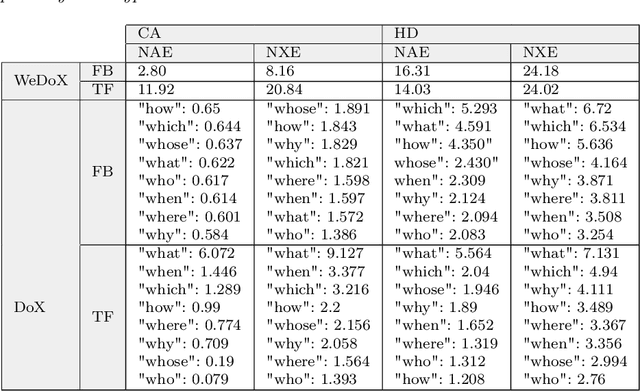


Abstract:Numerous government initiatives (e.g. the EU with GDPR) are coming to the conclusion that the increasing complexity of modern software systems must be contrasted with some Rights to Explanation and metrics for the Impact Assessment of these tools, that allow humans to understand and oversee the output of Automated Decision Making systems. Explainable AI was born as a pathway to allow humans to explore and understand the inner working of complex systems. But establishing what is an explanation and objectively evaluating explainability, are not trivial tasks. With this paper, we present a new model-agnostic metric to measure the Degree of eXplainability of correct information in an objective way, exploiting a specific model from Ordinary Language Philosophy called the Achinstein's Theory of Explanations. In order to understand whether this metric is actually behaving as explainability is expected to, we designed a few experiments and a user-study on two realistic AI-based systems for healthcare and finance, involving famous AI technology including Artificial Neural Networks and TreeSHAP. The results we obtained are very encouraging, suggesting that our proposed metric for measuring the Degree of eXplainability is robust on several scenarios and it can be eventually exploited for a lawful Impact Assessment of an Automated Decision Making system.
 Add to Chrome
Add to Chrome Add to Firefox
Add to Firefox Add to Edge
Add to Edge